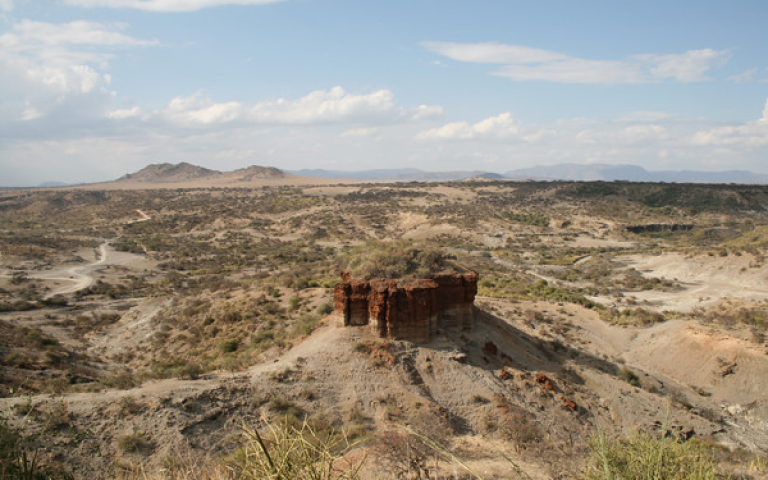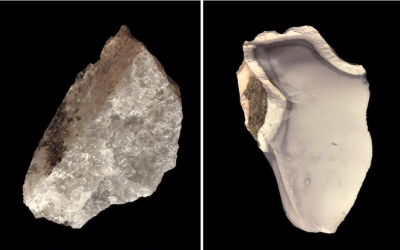Early humans optimised stone tool use at Tanzania’s Olduvai Gorge
8 January 2020
Early Stone Age populations living up to 1.8 million years ago made complex decisions in selecting different types of stone to optimise a variety of cutting tools, according to a new study by UCL, University of Kent and the Centre for Human and Social Sciences, Spain.

The study, published in the Journal of Royal Society Interface, offers new insight into the complexity of stone tool use, design and production. The researchers suggest that the hominins selected raw materials based on their sharpness and durability while also factoring in how long a tool was intended to be used for, their relative functional performance and the distance hominins had to travel to raw material sources.
The research is based on evidence from mechanical testing of the raw materials and artefacts found at Olduvai Gorge in Tanzania, one of the world’s most important sites for human origins research.
Dr Tomos Proffitt (UCL Archaeology), co-author on the study, said: “The decision processes underlying raw material selection behaviours represents a major element of Palaeolithic research, and is often vital to interpreting the behaviour and cognitive capabilities of early hominins.”
Lead author, Dr Alastair Key (University of Kent), said: ‘Why Olduvai populations preferentially chose one raw material over another has puzzled archaeologists for more than 60 years. This has been made all the more intriguing given that some stone types, including lavas and quartzite, were always available.
“What we’ve been able to demonstrate is that our ancestors were making quite complex decisions about which raw materials to use, and were doing so in a way that produced tools optimised for specific circumstances. Although we knew that later hominin species, including our own, were capable of such decisions, it’s amazing to think that populations 1.8 – 1.2 million years ago were also doing so.”
Olduvai Gorge has three main raw material groups suitable for producing stone tools; lavas, chert, and quartzite. Each was used by hominins, but their selection varies chronologically, between sites, and is dependent on the tool type produced. The pre-historic industry of stone tool production at this site is described as the Oldowan.
The scientists employed experimental methods more commonly used in modern engineering research. They found that chert was selected for flakes (tools made from smaller pieces of stone) and retouched tools. Lavas were used to produce flakes, cores (tools made from chipping and shaping large stones) and large cutting tools, such handaxes. While, quartzite was used predominantly for the production of small flakes (chipped stone tools).

Chert and quartzite from Olduvai Gorge were shown to be significantly sharper than basalt collected from the same location; however, basalt was shown to be more durable.
By selecting the material best suited to specific functional needs, hominins optimised the performance of their tools and ensured that tool efficiency and ‘ease-of-use’ was maximised.
Dr Proffitt (UCL Archaeology), said: “Early hominins during the Oldowan were probably using stone flakes for a variety of tasks. Mostly for butchering animals whilst scavenging, but also probably for cutting various plants and possibly even shaping wood. A durable cutting edge would have been an important factor when using these tools.
“There are many modern analytical techniques used in material sciences and engineering that can be used to interrogate the archaeological record, and many provide new insights into the mechanical properties of such tools and artefacts. By understanding the way that these tools work and their functional limits it allows archaeologists to build up a greater understanding of the capabilities of our earliest ancestors at the dawn of technology.”
The team now hopes researchers at other archaeological sites will want to apply similar mechanical tests and techniques to help understand the behaviour of Stone Age populations.
The research was funded by British Academy and the European Research Council.
Image
- Top image: Olduvai Gorge. Credit: flowcomm via Flickr
- Bottom image: Raw materials
Links
- UCL Institute of Archaeology
- Dr Tomos Proffitt’s academic profile
- Study in Journal of Royal Society Interface
Media contact
Natasha Downes
tel: +44 20 3108 3844
E: n.downes [at] ucl.ac.uk
 Close
Close

